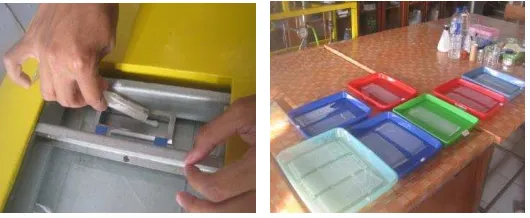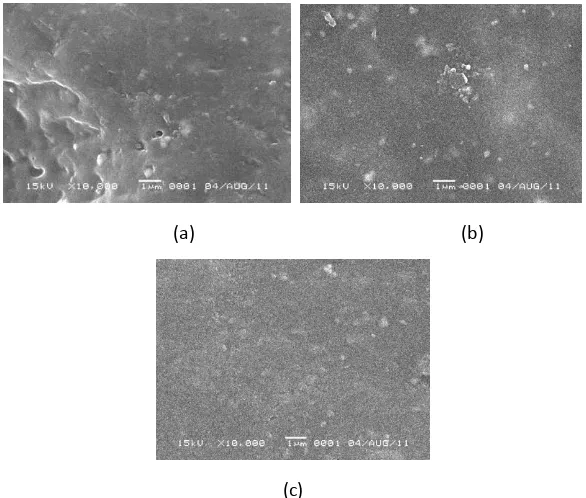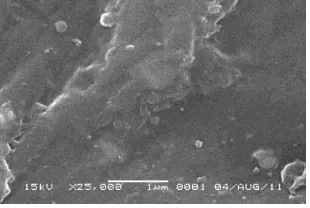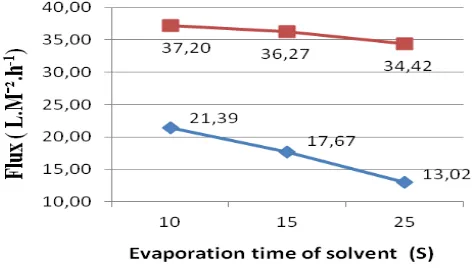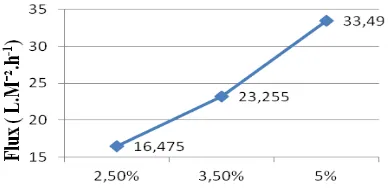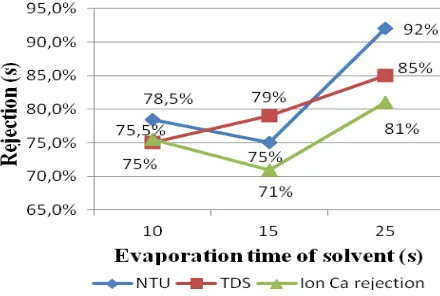Preparation and Characterization of Nanofiltration
Membrane for Water Treatment
Tutuk Djoko Kusworo, Eka Cahya Muliawati and Ardian Dwi Yudhistira Department of Chemical Engineering, Diponegoro University
Jl. Prof.Soedarto, SH.Semarang, 50239, Telp/Fax: (024)7460058 INDONESIA
E-mail : [email protected], [email protected], and [email protected]
Abstract :
Membrane technology has been developed significantly because it could be applicated on several fields. Therefore, in this study we report the manufactures of cellulose acetate nanofiltration membranes. The membranes were fabricated from dope solution consisting of cellulose acetate, poly ethylene glykol (PEG), distilled water, and acetone using a simple dry/wet phase inversion process. Production condition used included evaporation times of 10, 15, and 25 seconds, PEG addition of 2.5%; 3.5%; and 5%, with and without non-solvent addition of 1% distilled water in order to fabricate a high performance nanofiltration membrane. The mambranes performance that are based on percentage of rejection of barackish water and multivalent ion Ca2+, flux and mechanical strength of membrane. Generally, the percentage rejection and mechanical strength were found to increase and the flux were decrease with increasing of eveporation times. In the other side, the percentage of rejection, flux and mechanical were found to increase with increasing PEG addition. The percentage of rejection and mechanical strength were found the best in membranes with addition non-solvent of 1% distilled water, but the fluxes were the least. An optimimum membranes performance were found at compotition of dope solution composition consisting of 23% CA, 5% PEG, 25 seconds evaporation times and 1% distilled water.
Keywords: asymmetric membrane, brackish water, cellulose acetate, evaporation time, PEG
1. Introduction
Membranes general definition could be a selective barrier between two phases. The benefits of membrane technology are separation can be carried out continuously, low energy, hybrid processing, separation can be carried out under mild conditions, up-scalling is easy, membrane properties are variable and can be adjusted, no additives are required. With the advantages of membrane technology used in more extensive applications, such as desalination of sea water and brackish water, the separation and concentration of industrial waste water (waste water treatment), purification and sterilization of drinking water, gas separation, biotechnology [1]. Research related to the condition of making membrane is still interesting. This is because of the many parameters that affect characteristics of the resulting membrane. The combination of various parameters allows obtaining tailor-made membranes that are specific to a particular separation purposes.
The manufacture of membranes with addition of PEG additive has the effect of increasing rate membrane permeation because PEG is known as a pore-forming organic material on the membrane [2, 3, 4, 5]. Increasing amout of PEG can increase the porosity of the chitosan-cellulose composite membranes, which is shown through an increase in flux of the membrane [6]. PEG is a biocompatible compound, highly hydrophilic and anti-fouling [7].
The maximum flux will be obtained on the critical shear rate, where the increases of shear rate after the critical point of shear rate will decrease flux [8, 9, 22]. Solvent evaporation time clearly indicated that the longer evaporation times of solvent would result a thicker membranes surface and reduce pore size as a result of the formation of high polymer concentration on the area around dope - a layer of air, causing increased membrane selectivity and low flux [10]. Asymmetric pore structure could be obtained by considering evaporation of solvent and coagulant temperature during casting of the membrane [11].
Previous research has also been made for additional water in the membrane dope solution. Non-solvent with the addition of water will give the top layer structure of asymmetric membranes with the membrane pores are more open so that it will provide a higher flux values. Membrane formation mechanism will change from delayed demixing to the mechanism of formation of a more instantaneous membrane so that pore has begun to take shape when the addition of water [12,13].
The tools used include : Turbidimeter, pH meter, TDS meter, glass plates, casting knife, Permeabillity Cell, Fourier transform infrared (FTIR), Scanning Electron Microscope (SEM), Texture Analyzer.
2.2. Methods
Beginning process of manufacture membrane which made the solution polymer dope consisting of cellulose acetate, acetone as a solvent, then added additives polyethylene glycol, and non-solvent was distilled water. After all the ingredients mixed completely fit variable, then the dope solution allowed standing for 1 hour to remove bubbles. Casting membrane using the method of phase inversion that was casted on a glass plate using a casting
knife and allowed to evaporate with the time variation of evaporation and then immersed into a coagulation bath containing distilled water in place for 1 day at room temperature. Subsequently membranes was cut to fit the filtration cell for the characterization of the flux and rejection.
Figure 1. Casting Membrane (left) and Flat sheet Membran (right)
Figure 2. Flux Measurement Cell (1). Feed (2). Membrane (3). Retentate (4) Permeate
3. Result and Discussion.
3.1. Effect addition of PEG additive in Membrane Morphology
In Figure 3 of the image were asymmetric membranes along with increases of additional PEG, Fig. 3.b and 3.c the pores looked asymmetric and more uniform, looked on all the membrane pores were shape like a finger.
3
4 1
(a) (b)
(c)
Figure 3. SEM cross section of the membrane at addition of 2.5% PEG (a), 3.5% PEG (b), and 5% PEG (c)
From Figure 4 shown, in Figure 4.c there were differences in pore structure which denser. Along with the more addition of PEG, the membranes were more non-porous In Figure 4.a looked the membran thickness were uneven because at the time of casting is done manually.
(a) (b)
(c)
Figure 4. SEM top-surface of membrane at addition of 2.5% PEG (a), 3.5% PEG (b), and 5% PEG (c)
3.2. Effect of Evaporation Time In Membrane Morphology
Figure 5. SEM cross section of membrane at variation of evaporation time of 25 seconds without 1% aquades.
(a) (b)
Figure 6. SEM cross section of membrane at variation of evaporation time of 15 seconds (a) and 25 seconds (b) with the addition of 1% aquades
In Figure 7, and 8 there were a difference in the addition of distilled water. the membrane surface was denser and smoother than without the addition of distilled water. It was due to the addition of distilled water helped a lot in pore uniform formation and during the casting process is also much easier because the dope solution was more liquid. In figure 8.b at 25 seconds evaporation time, membrane surface looked smoother than the evaporation of 15 seconds in figure 8.a. It was because longer at delayed demixing process.
At Evaporation time of 25 seconds, a dense layer formed thicker due to the the longer evaporation time provided the opportunity of the top layer of skin to bind, therefore might result in increasing of rejection and decreasing of flux. A thicker dense layer would also increase the mechanical strength of the membrane which could be determined from a greater value of young modulus.
(a) (b)
Figure 8. SEM top surface of membrane at variation of evaporation time of 15 (a) and 25 (b) seconds with the addition of 1% aquades
3.3. Effect of solvent evaporation time on membrane flux measurements
Membrane flux was measured every 10 minutes to 1 hour with the operating pressure of 5 bar. Membrane area was 10,75 x10-4 m2 with the radius of each membrane 1.85 cm. In Figure 9 the evaporation of the solvent effected on the formation of the surface of the skin membrane. The longer evaporation time, a smaller pores size were formed in the top surface, tighter and smoother. It caused the value of the flux decreased and the rejection increased. Evaporation time also affeced in the pore size, the longer of evaporation time made pore on the top survace became small and selective [15]. It was because delayed demixing process occured in order to obtain non-porous membrane on the surface.
A Longer evaporation time made the polymer concentration on the top layer would increase and would inhibit the exchange rate between solvent and non-solvent through the membrane surface during the immersion process in the coagulation bath. This phenomenon caused smaller pore size formation of the membranes and finally will produced a smaller flux [16,17].
Addition of non solvent in dope solution would affect the structure of membrane. When there was no addition of water into the dope solution, the membrane formation through the mechanism of delayed demixing, in order to obtain nonporous membranes. The addition of water to the dope solution caused membrane pore structure more open [18].
Figure 9. Flux at different evaporation time of solvent with and without 1% distilled water addition.
3.4. Effect of addition of poly ethylene glycol (PEG) on membrane flux measurements
Figure 10. Flux at different PEG concentration
3.5. Effect addition of additives PEG on rejection Measurement
Membrane rejection was measured simultaneously with measurements of the flux of the membrane using a dead end filtration cell. Brackish water was used as feed. For the measurement of rejection, brackish water before and after passed through the membrane were tested using a Turbidimeter, TDS meter, and Ca2+ concentration by titration complexometri. Measurement of Ca2+ concentration are based on the ability nanofiltration membranes that can only reject the smallest particle like bivalent ions such as Ca2+ and Mg 2+ with the molecular weight range of 200-5000 [19].
From Figure 11 below shows that the addition of the composition of poly ethylene glycol (PEG) affected the membrane rejection. The higher concentration of PEG, the higher value of rejection.it was because the higher concentration of PEG, the smaller and uniform pore size would be formed, so the rejection values for turbidity, TDS values, and multi-valent Ca ion rejection increased. A smaller pore size could obtain a higher selectivity [1].
Membrane selectivity was expressed in the rejection coefficient, the membrane ability to pass of certain species and other species withstand. To calculate the value of rejection using the equation [20] :
R =1-f p
C
C
x 100% ,
R = Coefficient rejection (%), Cp= Concentration of solute in permeate, Cf= Concentration of in the feed
Figure 11. Rejection at different PEG concentration.
3.6. Effectof Evaporation Time of rejection Measurement
Figure 12 Rejection at different evaporation time of solvent without the addition of 1% distilled water
Figure 13. Graph between rejection membranes with each variation evaporation solvent with the addition of 1% distilled water
3.7. Analysis FTIR (Fourier Transform Infrared)
In Figure 21 it can be see n that the membrane has an OH group, C = O,-CH, and R-COH. The different between the absorbance analysis aceton + cellulose acetate membranes with cellulose acetate membranes aceton + PEG lied in different at the extent of absorption peaks at wave number 1629.6 and 1643.9 cm-1 cm-1. PEG itself may be indicated by the presence of functional groups C = O and the unit -CH2-CH2O- is the wave number 1438.4. In the figure 21 can be seen that the cellulose acetate + acetone + PEG area had a larger absorption peaks. The larger the absorption peaks indicated that increasing the addition of concentrations PEG could create the PEG molecular weight and the greater the unit -CH2-CH2O, which a flexible group in poly ethylene glycol, might reduce the rigidity chain. Therefore, it could affect the properties of PEG as soft segments forming [21].
In Figure 22 it can be seen that the membrane had an OH group, C = O, CH 3, - COOH, and C - O - C ether. It showed that the wavelength shift of chemical compounds happened during the evaporation of 15 and 25 seconds. The wavelength shift indicated that the evaporation time affected on the structure of the membrane morphology. On the absorbance of cellulose acetate membranes with evaporation time of 25 seconds at the wave number 3484.8 cm-1, -OH group had a greater area than the absorbance of cellulose acetate membrane with the evaporation time of 15 seconds at the wave number 3406.1 cm-1 and the evaporation time of 25 seconds wavenumber 1232.3 cm-1, the-COOH group had a larger area than the wave number of evaporation time of 15 seconds is 1269.7 cm-1.
Membrane rejection at evaporation time of 25 seconds showed a better result than at the evaporation time of 15 seconds. It was suggested that the evaporation time of 25 seconds to have an optimum rate of membranes. In Figure 22 the addition of distilled water with the composition of the dope solution, there was a wavelength shift and each of functional group had reduced area.
In addition to the SEM analysis results could be known that a smlaller finger-like macrovoid was formed in membran at evaporation time of 25 than the membrane with the evaporation time of 10 seconds. Finger-like macrovoid with a larger size would decrease the mechanical strength of the membrane so it would obtain the lower value of modulus young.
Table 1. Modulus Young measurements of the membrane with composition of 23% cellulose acetate, 5% PEG liquid, and evaporation time of 10, 15 and 25 seconds
Variation of Evaporation Time (Seconds) Modulus Young (N/cm2)
10 6338
15 7789
25 7977
From Table 2 showed that the addition of distilled water with 1% would increase the modulus young because the water could increase the hydrogen bonds so that the membrane formed more elastic and when the addition of water, the pores was beginning to take shape so that the number of pores would increase, denser and stronger at mechanical properties and resistance to pressure.
Table 2. Modulus young measurement with the membrane composition of 23% cellulose acetate, 5% PEG liquid, and evaporation time of 10, 15 and 25 seconds with the addition of distilled water
Variation of Evaporation Time (Seconds) Modulus Young (N/cm2)
10 7788 mechanical properties because the membrane was smooth and soft.
Table 3. modulus young measurement with a dope solution of 2.5%, 3.5%, 5% PEG liquid, 23% cellulose acetate
From the results of research could be concluded :
for TDS (dissolved solids); 85%, rejection for multivalent ions, namely Ca+2 by 81% modulus of 12 433 young N/cm2.
2. The addition of of polyethylene glycol (PEG) affected in pore formation with increasing the composition of the addition of PEG, the pore shape became smaller and improved the regularity of the pores formation in the membrane so that the greater the flux and rejection would be get.
3. Evaporation time of solvent affected on a smaller skin membrane pore formation resulting a smaller flux and greater value of rejection.
References
[1] Mulder, M. 1996. Basic Principles of Membrane Technology. Netherland: Kluwer Academic.
[2] Fadillah F. 2003. Pengaruh penambahan Poli etilen glikol terhadap karakteristik membrane selulosa asetat. Fakultas teknologi pertanian. Institut Pertanian Bogor.
[3] Rini P.A., Rum Hastuti dan Gunawan. 2008. Pengaruh Komposisi Poly Ethylene Glycol (PEG) Dalam Membran Padat Silika Dari Sekam Padi Dan Aplikasinya Untuk Dekolorisasi Limbah Cair Batik. Jurusan Kimia, Fakultas MIPA,Universitas Diponegoro. Semarang.
[4] Mohammadi, T. 2009. Effect of Production Conditions on Morphology and Permeability of asymmetric cellulose acetate membranes. Vol 243. hlm 1-7.
[5] Saljoughi E. 2010. Effect of PEG additive and coagulation bath temperatureon the morphology permeability and thermal/chemical stability of asymmetric CA membranes. Vol.262. hlm 72-78.
[6] Yang L., Hsiao W., and Chen P. 2001. Chitosan-cellulose composite membrane for affinity purification of biopolymers and immunoadsorption. Elsevier. Journal of Membrane Science. Vol 197. Page : 185-197.
[7] Su Y.L., Wei Cheng, Chao Li, and Zhongyi Jiang. Preparation of antifouling ultrafiltration membranes with poly(ethylene glycol)-graft-polyacrylonitrile copolymers. Elsevier. Journal of Membrane Science. Page : 246-252
[8] Ali, Nora’ai i, N. Syaza a A. Hali , A. Jusoh, a d Azizah E dut. 2009. The For atio a d Characterizatio of A Asymmetric Nanofiltration Membrane For Amonia-Nitrogen Removal : Effect of Shear Rate. Elsevier : Biosource Technology 101 : 1459-1465.
[9] Ismail A.F., A.R. Hassan and Ng be Cheer. 2002. Effect of Shear Rate on The Performance of Nanofiltration Membrane For Water Desalination: Songklanakarin J. Sci. Technol. Page : 879-889.
[10] Bhongsuwan D. and Bhongsuwan T. 2008. Preparation of Cellulose Acetate Membranes For Ultra-Nano-Filtrations: Kasetsart J.(Nat.Sci) 42:311-317.
[11] Cristina, R. 1998. Structure of water in asymmetric celullose ester membrans-an ATR FTIR study,Journal of Membran Science.
[12] Ciptaraharja I.. 2006. Membran Nanofiltrasi untuk penghilangan ion valensi tinggi dan senyawa organik dari sumber air salinitas tinggi. Jurnal Teknik Kimia Indonesia. Vol 5, No 3. Hal : 478-489.
[13] Ismail A.F., Suhana Jalil, and Shahrir Hashim. 2004. Preparation and characterization of polyethersulfone hollow fiber nanofiltration membranes made from PES/NMP/PEG 400/WATER. Science direct : Journal of Membrane Sciennce. [14] Ren, Jizhong and Rong Wang. 2011. Preparation of Polymeric Membranes : Handbook of Environmental Engineering :
Membrane and Desalination Technology. Vol. 13. Page : 47-100.
[15] Marlina, Saiful S., Johan. 2002. Pengaruh Jumlah Formamida dan Waktu Evaporasi Pada Pembuatan Membran Selulosa Asetat. Jurnal Natural. Vol 2, No 1. Hal 14-20.
[16] Li, G. 2009. An Experimental Investigation of Evaporation Time and The Relative Humidity On A Novel Positively Charge Ultrafiltrarion Membrane Via Dry-Wet Phase Inversion : Elsevier. Journal of Membrane Science 326.Page : 168-177. [17] Soroko and Iwona. 2011. The Effect of Membrane Formation Parameters on Performance of Polyimide Membrane For
Organic Solvent Nanofiltration (OSN). Part B : Analysis of Evaporation Step and The Role of Co-Solvent: Elsevier. Journal of Membrane Science. Page : 163-171.
[18] Mumpuni. 2011. Pembuatan Membran Komposit Pervaporasi Berbasis Poliether Sulfone-Biopolimer Untuk Dehidrasi Bioethanol. Thesis teknik kimia. Universitas Diponegoro. Semarang.
[19] Ren, J. dan R. Wang.2011. Preparation of Polymeric Membranes : Handbook of Environmental Engineering : Membrane and Desalination Technology. Vol. 13: 47-100.
[20] Dasilva, M. S. F. 2007. Polyamide and Polyetherimide Organic Solvent Nanofiltration Membranes. Disertation. University Of Nova De Lisboa.
[21] Rohaeti E., 2003. Pengaruh variasi berat molekul poli etilen glikol terhadap sifat mekanik poliuretan. Jurnal matematikadan sains. Vol 8. No 2.
[22] Ismail A.F. and A.R. Hassan. 2005. Formation and Characterizayion of Asymetric Nanofiltration Membrane : Effect of Shear Rate and Polymer Concentration. Science direct : Journal of Membrane Sciennce 270 : 57-72.
